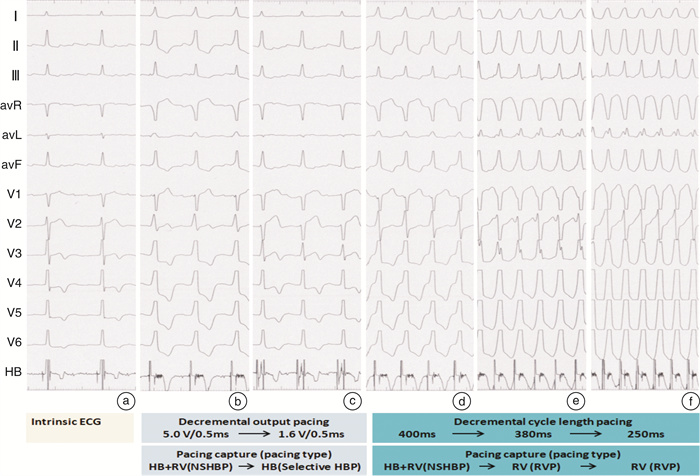Comparison of the electrophysiological characteristics of the His-bundle and the adjacent myocardium
-
摘要: 目的 比较希氏束及其周围心室肌兴奋性及传导性的差异。方法 242例QRS波正常(QRS波形态正常,且时程 < 120 ms)的患者(第1组)和60例完全性左束支传导阻滞伴心力衰竭的患者(第2组)进行了希氏束起搏。通过对术中出现非选择性希氏束起搏的患者测量希氏束及其周围心室肌的起搏阈值(PT)和有效不应期(ERP),比较二者兴奋性及传导性的差异。结果 第1组和第2组出现非选择性希氏束起搏的患者分别为190例和34例。所有患者希氏束的ERP均长于各自周围心室肌的ERP至少20 ms。第1组患者希氏束的PT与其周围心室肌的PT比较差异无统计学意义[(1.1±0.5) V vs(1.1±0.6) V,P=0.47],其中希氏束的PT高于、低于和等于其周围心室肌的PT各91例(47.9%)、87例(45.8%)和12例(6.3%)。第2组患者希氏束的PT高于其周围心室肌的PT[(2.5±0.9) V vs(1.6±0.8) V,P< 0.01],其中希氏束的PT高于、低于和等于其周围心室肌的PT各28例(82.3%)、6例(17.6%)和0例(0%)。结论 希氏束的传导性低于其周围心室肌,QRS正常患者希氏束及其周围心室肌的兴奋性无明显差异。Abstract: Objective To compare the differences in the excitability and conductivity of the His-bundle(HB) and its adjacent ventricular muscles.Methods His-bundle pacing was performed in 242 patients with normal QRS(QRS < 120 ms) wave(group Ⅰ) and 60 patients with complete left bundle branch block with heart failure(group Ⅱ). Differences in excitability and conductivity were compared by measuring the pacing threshold(PT) and effective refractory period(ERP) of HB and adjacent myocardium in patients with NSHBP.Results Number of group Ⅰ and group Ⅱ patients with NSHBP were 190 and 34. All these patients the ERP of the HB was at least 20ms longer than that of the respective adjacent myocardium. There was no significant difference between PT of HB and adjacent myocardium in group Ⅰ[(1.1±0.5) V vs(1.1±0.6) V,P=0.47]. The PT of HB was above, below, and equal to adjacent myocardium were 91(47.9%), 87(45.8%) and 12(6.3%) cases, respectively. In the group Ⅱ, PT of HB was higher than PT of adjacent myocardium[(2.5±0.9) V vs (1.6±0.8) V,P< 0.01]. The PT of HB was above, below, and equal to adjacent myocardium were28(82.3%), 6(17.6%) and 0(0%) cases, respectively.Conclusion The conduction of HB was lower than that of its surrounding ventricular muscle, and there was no significant difference in the excitability of HB and its surrounding ventricular muscles in patients with normal QRS.
-
Key words:
- effective refractory period /
- his-bundle pacing /
- pacing threshold
-

-
表 1 两组基线特征
Table 1. Baseline data between the two groups
X±S 项目 第1组 第2组 患者/例 242 60 年龄/岁 63.4±13.2 64.9±12.6 男性/例(%) 138(57.0) 33(55.0) 心律失常类型/例(%) 病态窦房结综合征 28(11.6) 0(0) 二、三度房室传导阻滞 165(68.2) 0(0) 心房颤动伴慢心室率 49(20.2) 0(0) LBBB 0(0) 60(100.0) 自身QRS持续时间/ms 90.8±10.0 169.6±14.1 H-V间期/ms 37.7±5.5 54.8±8.4 左室射血分数/% 60.3±6.5 28.7±4.7 基础疾病/例(%) 扩张型心肌病 0(0) 43(71.7) 缺血性心肌病 37(15.3) 17(28.3) 无明显基础疾病 205(84.7) 0(0) H-V间期:希氏束至心室波起始的距离。 表 2 两组NSHBP患者起搏类型变化的条件和结果
Table 2. Conditions and outcomes of pacing type changes in NSHBP groups
X±S 项目 第1组 第2组 NSHBP患者/例 190 34 降低电压起搏类型的转变/例(%) QRS缩窄(NSHBP到SHBP) 87(45.8) 6(17.6) QRS增宽(NSHBP到RVP) 91(47.9) 28(82.3) QRS不变(NSHBP到失夺获) 12(6.3) 0(0) PT/V 希氏束 1.1±0.5 2.5±0.9 周围心室肌 1.1±0.6 1.6±0.8 P值 0.47 < 0.01 提高频率起搏类型的转变/例(%) QRS缩窄(NSHBP到SHBP) 0(0) 0(0) QRS增宽(NSHBP到RVP) 190(100.0) 34(100.0) QRS不变(NSHBP到失夺获) 0(0) 0(0) ERP/ms 希氏束 319.5±29.5 315.6±25.6 周围心室肌 265.0±16.1 267.9±15.7 P值 < 0.01 < 0.01 -
[1] Ali H, Foresti S, Lupo P, et al. Para-hisian pacing: new insights of an old pacing maneuver[J]. JACC Clin Electrophysiol, 2019, 5(11): 1233-1252. doi: 10.1016/j.jacep.2019.08.017
[2] 姜述斌, 周俊, 吴忠东, 等. 希氏束旁起搏鉴别间隔部隐匿性房室快旁道的临床价值[J]. 临床心血管病杂志, 2013, 29(2): 137-140. https://www.cnki.com.cn/Article/CJFDTOTAL-LCXB201302020.htm
[3] 魏经汉. 希氏束起搏: 起搏器治疗的新未来[J]. 临床心血管病杂志, 2018, 34(11): 1044-1047. https://www.cnki.com.cn/Article/CJFDTOTAL-LCXB201811002.htm
[4] Glikson M, Nielsen JC, Kronborg MB, et al. 2021 ESC Guidelines on cardiac pacing and cardiac resynchronization therapy[J]. Eur Heart J, 2021, 42(35): 3427-3520. doi: 10.1093/eurheartj/ehab364
[5] 中华医学会心电生理和起搏分会, 中国医师协会心律学专业委员会. 希氏-浦肯野系统起搏中国专家共识[J]. 中华心律失常学杂志, 2021, 25(1): 10-36.
[6] Jastrz
[7] Liang Y, Yu H, Wang N, et al. Cycle length criteria for His-bundle capture are capable of determining pacing types misclassified by output criteria[J]. Heart Rhythm, 2019, 16(11): 1629-1635. doi: 10.1016/j.hrthm.2019.04.032
-





 下载:
下载: